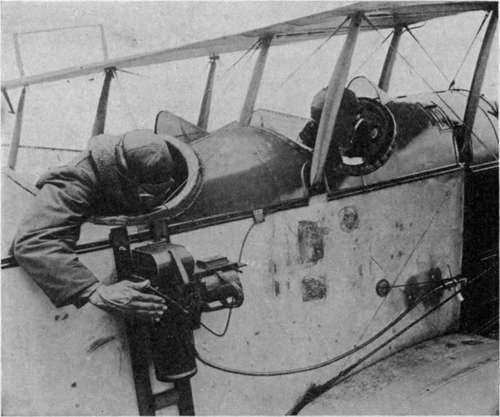Chapter XV. Practical Camera Mountings. General Considerations
Description
This section is from the book "Airplane Photography", by Herbert E. Ives. Also available from Amazon: Airplane photography.
Chapter XV. Practical Camera Mountings. General Considerations
Camera mountings as used during the war were far from being developed on the basis of scientific study or test. At first the need for special supporting apparatus was not realized, and the suspensions later in use were largely field-made affairs, often dependent on adjustments made according to individual taste. Through lack of accurate methods of test and of conclusive evidence on the subject, it was quite common to find extremists who, on the one hand, denied the efficacy of suspensions in general, and on the other ardently supported crazily conceived supporting arrangements which accurate comparative test show to be even worse than useless.
In the French service, despite numerous types of suspension available, the very general practice was to lift the camera from its support and hold it between the knees. Or else the hand was pressed on the top of the camera during exposure, more reliance being placed on the damping qualities of the body than on any of the rubber or spring mechanisms.
As is clearly shown by the experimental data described in the last chapter, a correctly designed supporting device, carrying the camera accurately in the plane of its center of gravity, accomplishes practically perfect elimination of vibrational troubles. So important is the use of a mount and so important is it that the mount should be correctly dimensioned and adjusted for the camera, that an entirely different attitude should be adopted from the prevalent one which focuses attention on the camera and regards the mounting as a mere auxiliary to be left more or less to chance. The mounting should he considered an integral part of the camera. The man in the field should receive camera and mount together, leaving as his only problem the attachment of the complete camera—and—mount unit to the plane. This may be arranged, by proper designing, to be a simple matter of rigid bolting or strapping, requiring ingenuity perhaps but not the scientific knowledge which is required for mounting design.

Fig. 81. - "L" camera mounted outside the fuselage. Observer using exposure plunger, pilot using Bowden wire release.
Continue to:
Tags
camera, lens, airplane, aerial, film, exposure, photography, maps, birdseye
